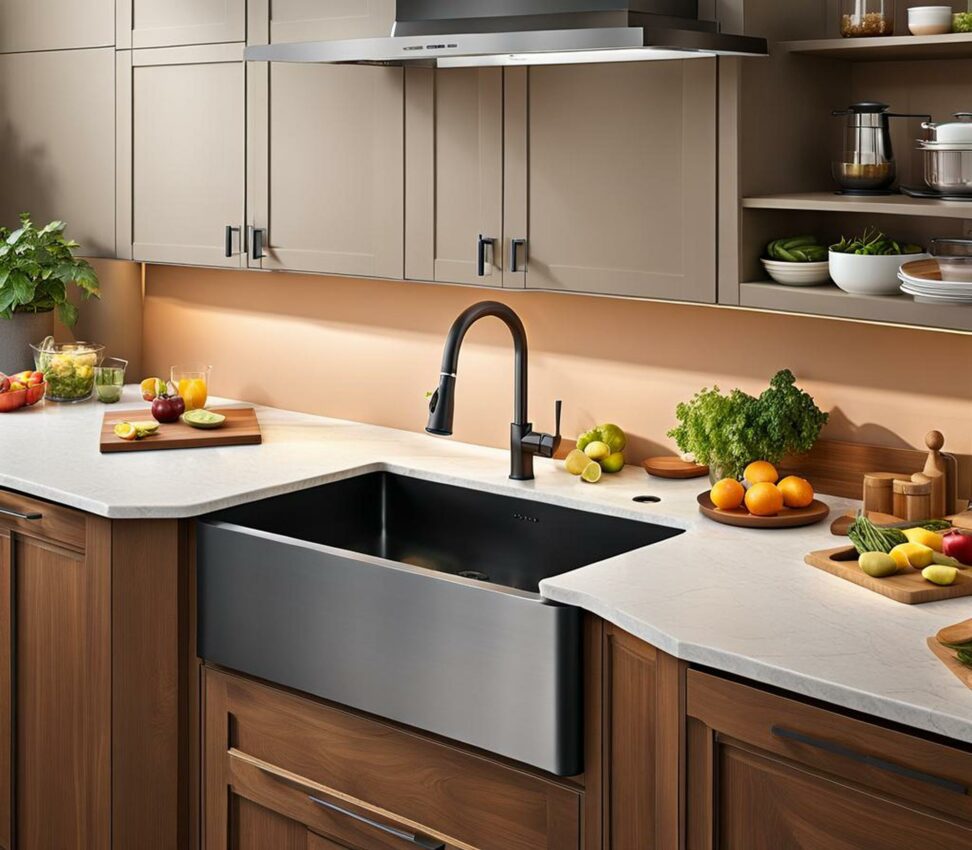Boost Kitchen Functionality with the Perfect Prep Sink Size
Having an efficient kitchen workflow can make meal prep feel effortless. But when your main sink is overflowing with dirty dishes, food scraps, and other messy tasks, prepping ingredients can become a challenge.
This is where a properly sized prep sink can transform your cooking experience. By designating an auxiliary prep sink near food workstations, you’ll optimize your kitchen’s function.

Standard Kitchen Sinks vs. Prep Kitchen Sinks
To understand ideal prep sink sizes, it helps to first look at typical kitchen sink dimensions.
The standard kitchen sink installed as the home’s primary cleanup station is usually quite large. Here are some typical measurements:
- Width: 22-33 inches
- Length: Roughly 25-30 inches
- Depth: 7-10 inches
This size provides ample room for washing dishes, filling stock pots, and handling other messy jobs. Standard kitchen sinks are designed as multi-purpose basins.
Prep sinks, on the other hand, serve specific purposes apart from the main sink. They’re typically situated near food prep areas for tasks like washing fruits and vegetables.
The smaller size is optimized for minor cleanup rather than big jobs like soaking casserole dishes. When correctly sized, a prep sink adds workflow efficiency.
Width and Length Guidelines
For maximum function, determining the proper prep sink width and length is key. Here are some typical size guidelines:
Mini Prep Sinks- Width: 9-12 inches
- Length: 10-15 inches
- Width: 15-18 inches
- Length: 15-20 inches
In terms of depth for optimal ergonomics:
- Mini prep sinks: 5-7 inches
- Small prep sinks: 7-9 inches
Choosing the Right Sink Size
Within these general size parameters, the ideal dimensions for your kitchen depend on:
- Available space in your existing layout
- What you’ll use the sink for
- Number of simultaneous users
- Fit with cabinets and countertops
If your prep sink will be used for washing large sheets pans or accommodating bigger tasks, the larger end of the small prep sink range is best. But for a dedicated produce washing station, a compact mini prep sink could suffice.
Basin Shape and Preference
The shape of your prep sink basin also deserves consideration. The most common options are:
- Round - A single rounded basin
- Square - A squared-off basin with 90-degree corners
- Rectangular - A longer rectangular basin
Here’s an overview of the pros and cons of each approach:
Round Prep Sink Basins
Pro: Great for fitting in tight spaces where every inch matters. A rounded mini prep sink can squeeze into a small vacant space between countertop appliances.
Con: The curved edges reduce overall capacity. Square and rectangular sinks make better use of available space.
Square Prep Sink Basins
Pro: The right-angled corners maximize the basin’s holding capacity. Water flows away easily as well.
Con: The 90-degree corners can be tricky to keep clean. Gunk tends to collect in these areas.
Rectangular Prep Sink Basins
Pro: An elongated rectangle can accommodate more dishes, pans, etc. Great for placement near stoves.
Con: Takes up more lateral counter space than a compact round or square basin.
Improving Functionality
Installing a properly sized auxiliary prep sink in your kitchen design improves functionality and workflow in several key ways:
- Lets you prep ingredients even while the main sink is piled high with dishes.
- Provides a dedicated cleaning station for produce away from raw meat and poultry.
- Positioned at the ideal height, reaching and straining are minimized.
- Certain models have drainboards to extend the workspace.
- Enables workflows like “clean” and “dirty” sides for washing and rinsing.
Your prep sink doesn’t need to match your main sink basin material or mounting style. Focus on finding the right size and basin shape for your particular kitchen layout and tasks.
Optimal Placement
To make the most of your prep sink, optimal placement is also key. The best locations are:
- Near cutting boards, food processors, and other appliance “workcenters”
- Adjacent to stoves or ovens for easy food transfer
- Close to the fridge so ingredients are within reach
Corner placements with access from two countertop sides are ideal. This allows multiple people to use the sink at once.
Don't Overlook the Faucet
Along with the right sized basin, upgrading your faucet can also improve efficiency. Look for prep sink faucets with features like:
- Pull-down spray heads for rinsing
- Motion sensors for hands-free activation
- Swivel spouts for increased reach
- Water saving low-flow designs
Your prep sink faucet can match other finishes in the kitchen, or go for a unique style to accent the space.
Optimizing your kitchen workflow is all about having separate, dedicated spaces for different tasks. With the right sized prep sink installed near food workstations, you’ll get function and flexibility.
Keep these sink sizing tips in mind:
- Standard kitchen sinks are larger (22-33 inches wide).
- Prep sinks range from 9-18 inches wide based on tasks.
- Allow adequate length for pans and cookie sheets.
- Choose basin shape based on space and preferences.
- Position next to appliances for a seamless workflow.
By tackling messy clean-up jobs in your main sink, and keeping ingredient washing and prepping confined to a properly sized auxiliary basin, you'll get cooking with optimized efficiency.